The Nebulae
Out of the Remnants of Gas & Dust - Stellar Birth









You should know
»» Nebula & Nebula Classification - A nebula ( Latin: "mist"; pl. nebulae ) is an interstellar cloud of dust, gas and plasma. Originally nebula was a general name for any extended astronomical object, including galaxies beyond the Milky Way ( some examples of the older usage survive; for example, the Andromeda Galaxy is sometimes referred to as the Andromeda Nebula ). Nebulae can be classified by how they are illuminated:







Omega Nebula - NGC 2174 - NGC 1435 - Mz3 the Ant Nebula - Supernova Remnant - LDN 1622 - Gomez's Hamburger
- Diffused Nebulae (Omega Nebula) are illuminated nebulae that are extended, containing no well-defined boundaries. These nebulae are usually classified into Emission and Reflection types.
- Emission Nebulae (NGC 2174) are internally illuminated clouds of ionized gas. Two of the most common types of emission nebula are H II regions and Planetary nebulae.
- Reflection Nebulae (NGC 1435) are illuminated by reflections from nearby stars. An example is the nebulosity NGC 1435 surrounding the Pleiades star cluster
- Planetary Nebulae (Mz3) are compact shells of gas around a dead star or an intermittantly active star.
- Supernova Remnants (Supernova) are the results of the massive and cataclysmic detonation of a star. The resulting blast causes the remnants of the star to move away from it's original location at high speed, the debris thereby heated by colliding with (relatively) slow moving galactic dust and gas.
- Dark or Absorption Nebulae (LDN 1622) are unilluminated. They can be detected when they obscure stars or other nebulae. Famous examples include the Horsehead nebula in Orion, and the Coalsack Nebula in the Southern Cross.
- Protoplanetary Nebulae (Gomez's Hamburger) are an astronomical object which is at the short-lived episode during a star's rapid stellar evolution between the late asymptotic giant branch (LAGB) phase and the subsequent planetary nebula (PN) phase. However, this name is also in flux, see below.
- Post-AGB Star In order to avoid confusion in naming conventions; as in the above protoplanetary nebula & planetary nebula. The term preplanetary nebula or post-AGB stars has been suggested for use. see Sahai, Sanchez Contreras & Morris 2005 ]
Also See Classifying the Nebulae at the Ideas of Cosmology web site || Nebula: Encyclopedia - Nebula || Wikipedia: Nebula
»» H II region - A region of interstellar hydrogen that is ionized giving this nebula it's red color. The notation H II refers to the fact that the hydrogen atoms (H) are ionized (H I is neutral, un-ionized hydrogen). see: Definition of H II region from Encyclopedia.com. An H II region (also known as emission nebula) is a cloud of glowing gas and plasma, sometimes several hundred light-years across, in which star formation is taking place. Young, hot, blue stars which have formed from the gas emit copious amounts of ultraviolet light, ionising the nebula surrounding them. see 2008/9 Schools Wikipedia Selection
»» Proplyds or Protoplanetary Discs - a rotating disk of dust and gas that surrounds the core of a developing solar system. It may eventually develop into orbiting celestial bodies such as planets and asteroids. see Protoplanetary disk A young newly formed star, a T Tauri star or Herbig star. The protoplanetary disk may be considered an accretion disk because gaseous material may be falling from the inner edge of the disk onto the surface of the star, but this process should not be confused with the accretion process thought to build up the planets themselves. Wikipedia - Protoplanetary disk
»» Gravitational accretion - a dense core of gas and dust which becomes more and more dense by drawing material into the core. This is called accretion. This process forms accretion disks of which many have been identified with the Hubble Telescope. The core heats up (to about 1500 K) because of the compression, caused by gravity, and begins to shine in the infrared and at radio wavelengths. After about 100,000 years of accretion the protostar has as much mass as the Sun. Eventually, the wind of radiation and particles flowing from the proto-star prevents further material from accreting. The proto-star becomes a pre-main sequence star. see Formation of Stars from Harrison B. Prosper at Florida State University
the nebula and the birthplace of stars
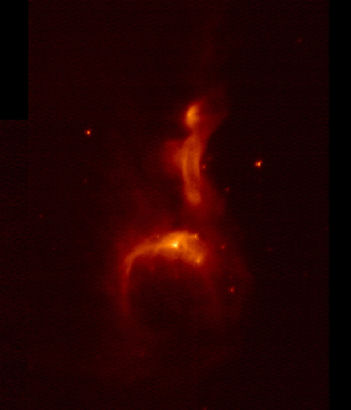
Akari's infrared image of reflection Nebula IC 4954 showing the birth of a star, from the Japan Aerospace Exploration Agency
You would almost think that star formation takes place out in the remotest corners of our vast universe or in the dark voids of the interstellar medium, but in fact, stars are continually "born" (technically, they form from a process called gravitional accretion) everwhere in our universe including our own Milkyway galaxy! The birthplace of stars is actually formed from the remnant of stars that have gone supernova or from the remains of older stars in the later stages of stellar evolution, Red Giant stars, which have shed their outer surface layers, casting their gas and dust into space via strong stellar winds, creating what we call a Nebula; see this site's page - Red Giant Stars:
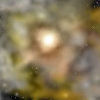 from A white Dwarf Emerges - K.Pinkela
from A white Dwarf Emerges - K.Pinkela
"There are two different origins of nebulae. The first origin for material is the universe's creation itself: Soon after its birth, atoms were created in the universe, and it is from these that the first dust and gas clouds formed. This means that the gas and dust that make up this type of nebula were not created in a star, but are the original matter from the beginnings of the universe. The second kind of nebulae are produced by the supernovas of exploding stars. The matter ejected from them created the Veil and Crab nebulae, as well as many more. Also, keep in mind that the origins of nebulae are not as clear cut as this; a nebula can be a mixture of primordial material as well as new material from previous stars." Stuart Robbins & David McDonald Journey through the Galaxy
from Supernova: explosive Cosmos - K.Pinkela 
Here are various images of nebulae and their star forming regions:

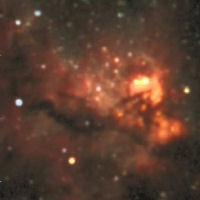
Nebula NGC 3582 within the star forming region known as RCW 57 APOD and HKsL (Blue=H, Green=Ks, Red=L) composite colour image of RCW 57 created using 2MASS and SPIREX images. From the survey report L-band (3.5 μm) IR-excess in massive star formation in .pdf format.

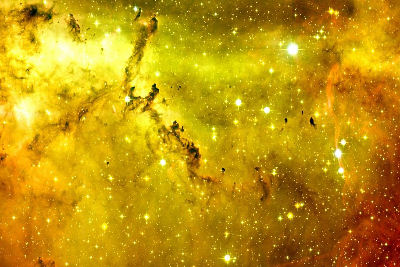
Star Forming Region in the Rosette Nebula and a close up of the lower region (southern in image) of the same image. This is from Canada-France-Hawaii Telescope / 2003.
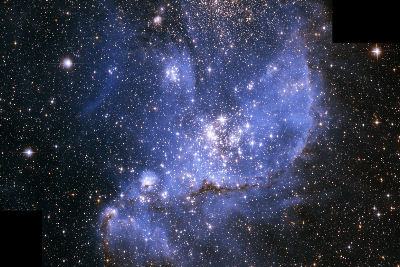
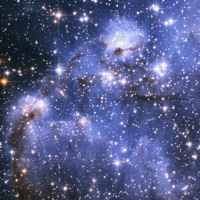
Star-forming region in nebula NGC 346 and close up. This beautiful image is from the European Space Agency website.
Stellar Birth in Infrared
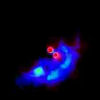
Infrared adaptive optics image of a T-Tauri stars (UY Aur) Laird Close, University of Hawaii
"Many of the most interesting infrared objects are associated with star formation. Stars form from collapsing clouds of gas and dust. As the cloud collapses, its density and temperature increase. The temperature and density are highest at the center of the cloud, where a new star will eventually form. The object that is formed at the center of the collapsing cloud and which will become a star is called a protostar. Since a protostar is embedded in a cloud of gas and dust, it is difficult to detect in visible light. Any visible light that it does emit is absorbed by the material surrounding it. Only during the later stages, when a protostar is hot enough for its radiation to blow away most of the material surrounding it, can it be seen in visible light. Until then, a protostar can be detected only in the infrared. The light from the protostar is absorbed by the dust surrounding it, causing the dust to warm up and radiate in the infrared. Infrared studies of star forming regions will give us important information about how stars are born and thus on how our own Sun and Solar System were formed." The Infrared Universe from Cool Cosmos - Author: Linda Hermans-Killam - Infrared Processing and Analysis Center/NASA
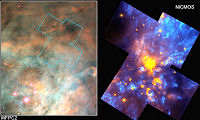
Hubble Captures the Heart of the Orion Nebula
NICMOS image: Rodger Thompson, Marcia Rieke, Glenn Schneider, Susan Stolovy (University of Arizona); Edwin Erickson (SETI Institute/Ames Research Center); David Axon (STScI), and NASA
WFPC2 image: C. Robert O'Dell, Shui Kwan Wong (Rice University) and NASA
"Hubble's visible-light view of the nebula is on the left...Hubble's infrared camera reveals a chaotic, active star birth region [as seen in the right-hand picture]. Here, stars and glowing interstellar dust, heated by and scattering the intense starlight, appear yellow-orange."

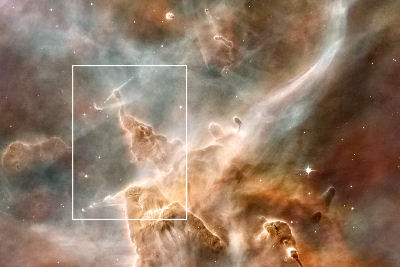
Our final images are from the star-forming region in the Carina Nebula. The close up of the larger region at right is infomally referred to as the "pillars of creation". Both of the above are smaller portions of the larger image that can be found at the Hubble site's Hertiage gallery, ESA or at the excellent SFL ORG. Educational News Network web site. Credit for Hubble Image: NASA, ESA, N. Smith (University of California, Berkeley), and The Hubble Heritage Team (STScI/AURA) Credit for CTIO Image: N. Smith (University of California, Berkeley) and NOAO/AURA/NSF
Credits & Further Reading
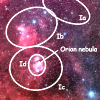 "The chemical composition of the Orion star forming region: stars, gas and dust." by Sergio Simón-Díaz
Observatoire de Genéve A nicely presented .pdf file on the Orion star forming region, Ori OB1 and the Orion nebula (M42)
"The chemical composition of the Orion star forming region: stars, gas and dust." by Sergio Simón-Díaz
Observatoire de Genéve A nicely presented .pdf file on the Orion star forming region, Ori OB1 and the Orion nebula (M42)
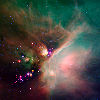 "Newborn stars peek out from beneath their natal blanket of dust in this dynamic image of the Rho Ophiuchi dark cloud...Rho Oph is a complex made up of a large main cloud of molecular hydrogen, a key molecule allowing new stars to form from cold cosmic gas..." from Rho Oph Cloud Star Forming Region Image Credit: NASA/JPL-Caltech/Harvard-Smithsonian Center for Astrophysics
"Newborn stars peek out from beneath their natal blanket of dust in this dynamic image of the Rho Ophiuchi dark cloud...Rho Oph is a complex made up of a large main cloud of molecular hydrogen, a key molecule allowing new stars to form from cold cosmic gas..." from Rho Oph Cloud Star Forming Region Image Credit: NASA/JPL-Caltech/Harvard-Smithsonian Center for Astrophysics
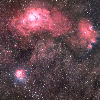 The Sagittarius Triplet "...are stellar nurseries about five thousand light-years or so distant." from APOD Image Credit & Copyright: Robert Gendler, Astrophotography
The Sagittarius Triplet "...are stellar nurseries about five thousand light-years or so distant." from APOD Image Credit & Copyright: Robert Gendler, Astrophotography
Circumstellar Regions and Ionized Nebulae from the Department of Physics and Astronomy: Annual Review 2002 Astronomy and Astrophysics.
Proto Planetary Disc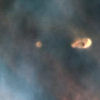 Star Formation "Intergalactic space is filled with clouds of gas (mostly H + He) and dust known as molecular clouds. These clouds are supported against gravitational collapse by their thermal pressure, but if the clouds get too big massive, gravity wins and they can start to collapse. This is the first step towards star formation." from Case Western Reserve University Department of Astronomy. Subjects include Angular Momentum and it's effects on stellar birth.
Star Formation "Intergalactic space is filled with clouds of gas (mostly H + He) and dust known as molecular clouds. These clouds are supported against gravitational collapse by their thermal pressure, but if the clouds get too big massive, gravity wins and they can start to collapse. This is the first step towards star formation." from Case Western Reserve University Department of Astronomy. Subjects include Angular Momentum and it's effects on stellar birth.
Next Section
Click here for PAGE TWO
for further study

 NASA Goddard Space Flight Center
NASA Goddard Space Flight Center
Nebulae & Starbirth
Diffused Nebula - Under Construction
Main Page
This Page
Nebulae & Starbirth
Next Page
Working On
Back to the Main Page
 Astronomers Discover Edge-on Protoplanetary Disk in Quadruple Star System from NOAO
Astronomers Discover Edge-on Protoplanetary Disk in Quadruple Star System from NOAO
Since this is an evolving website (a scientific way of say "always under construction") many of the pages on this site are continually being added to or updated. I do so as time permits and in a rotational fashion. As such, I'll be continuing this section after adding to those next in line. So please check back in two weeks or so.
Future upcoming chapters:
◊ Reflection Nebulae
◊ Planetary Nebulae
◊ Supernova Remnants
◊ Protoplanetary Nebulae